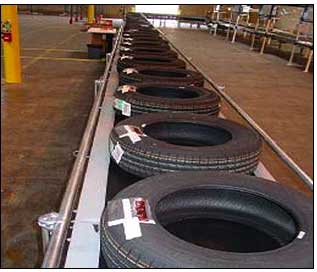Goodyear Tire & Rubber Co. is a supplier to both Wal-Mart and the U.S. Department of Defense and is subject to RFID mandates from both. The company plans to comply, but it faces some obstacles beyond what other suppliers have to do to achieve compliance.
“Tagging tires with a label is very challenging,” Steve Lederer, RFID project manager for Goodyear, said at the Digital ID World conference held in Denver recently. “We use a release agent to help get the tires out of a mold, and they are very slick as a result.”
The slickness makes it hard to get ordinary RFID labels to stick to the tires. The tires are made with reinforced carbon for durability, and the carbon absorbs RF energy, which makes it harder to read a tag placed on the tire.
Tires are also shipped to Wal-Mart and the DOD as unpackaged items, which means they can be banged around. It also means that the tires can be stacked vertically or horizontally when being shipped, which makes it hard to anticipate the orientation of a tire’s RFID tag to a reader.
Goodyear has been working with Sun Microsystems at Sun’s RFID test center to assess a variety of tags on tires stacked vertically and horizontally. “We’ve been working to find the right spot on the tire and to find a tag that is durable and can be used in all ways tires are handled in our operations.”
Lederer says Goodyear expects to achieve some internal benefits from tracking “light tires”—those used on automobiles, as opposed to earth-moving equipment and trucks—in its supply chain. Tires sometimes get shipped to the wrong store, and RFID can help reduce such shipping errors and provide better inventory visibility. Lederer also said that RFID could help reduce the cost of complying with the Transportation Recall Enhancement, Accountability, and Documentation (TREAD) Act, which the U.S. Congress passed in 2000 in the wake of the Firestone-Ford Explorer debacle.
“Tires have to have a unique identification number called a DOT number,” he said. “Cars have a vehicle identification number. Under the TREAD Act, carmakers have to associate the unique number on each tire with the VIN of the car it’s put on. RFID offers a cheaper way to do that association.”
Lederer said that Goodyear expects to use low-cost, disposable RFID tags on light tires and more expensive, permanent tags on heavy tires. That’s because the life of heavy tires is longer and the investment that end users make in the tires is great. Companies that buy heavy tires want to make sure the tire pressure is optimal to maximize the life of the tire. RFID tags combined with a temperature and pressure sensors would provide an easy way to gather information on the condition of the tire and make adjustments.
“For trucking companies, tires are the second-biggest operational expense, right behind fuel,” he said. “If a company that takes good care of its tires sends a tire carcass out to be retread, it wants to get the same carcass back and not the carcass of a tire from a trucking company that doesn’t take care of its tires. There’s a need to be able to track that information.”
Goodyear does have special RFID labels that can be used on new light tires and will comply with RFID mandates from Wal-Mart and the DOD. Lederer said the company doesn’t expect that the benefits RFID provides within its supply chain will offset the cost of the tags, readers and other elements of an RFID system in the short term. But it sees RFID as a longer-term opportunity to achieve great supply chain efficiencies.


